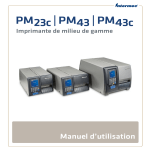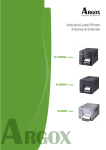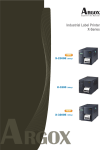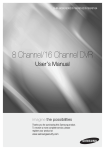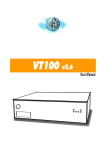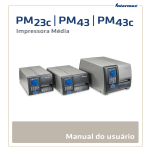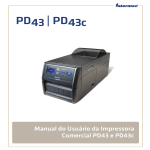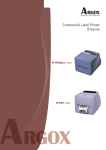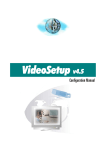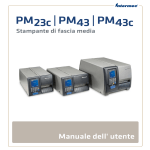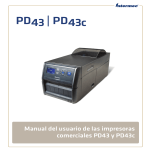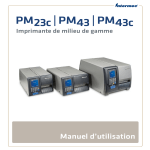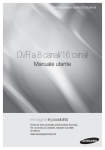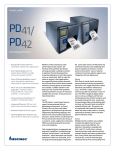Download PD41/PD42 Migration Considerations For PD43
Transcript
TECHNOLOGY BRIEF PD41/PD42 Migration Considerations For PD43 Introduction This document discusses migration from Intermec’s PD41 and PD42 to its replacement, the PD43 industrial printer. Intermec’s PD43 includes many modern features, simplified user interfaces and powerful 1:1 device management. The PD43 is also designed for backward compatibility to the PD41/PD42 for most features, including features like Smart Printing and media support. However, there are some differences to be considered for those upgrading from the old to the new printer. We will review each Supported Command Languages migration consideration and suggest The PD43 printer supports the same printer command languages as PD41/PD42 and adds a new Smart Printing language, C#, which makes it easier to develop custom applications. The differences of the supported command languages are captured in the differences documentation, i.e. IPL, ESim and Fingerprint respectively. ways to minimize any impacts. The use of the migration document is best supplemented with PD43 and PD43c User Manual Supported Printers This document focuses on the migration considerations from PD41/PD42, however there are a number of new features that are important to notice New Features This document focuses on the migration considerations from PD41/PD42, however there are a number of new features that is important to notice. • Localized User Interface (10 languages) • Linerless Media Support Virtual COM support • Color LCD with Localization Capability • • RFID HF and UHF • 8 ips Printing Speed • Bluetooth Support v2.1 + EDR • CCX Certification v4 •Buzzer/Speaker • Wireless 802.11n 2.4GHz • • User Replaceable Platen Roller RTC as standard 1 TECHNOLOGY BRIEF Environment Due to the door opening design the width of the PD43 doubles when the door is open. PD43 works in a wider range of industrial environments compared to PD41/PD42, as shown here. PD41 PD42 Height Width Depth Weight 273mm 270mm 453mm 13kg PD43 PD41 / PD42 Operating Temperature 5C to 40C 5C to 40C Storage Temperature -40C to 60C -20C to -50C Flat Door 205mm 211mm 490mm 8.3kg 246mm 211mm 490mm 8.4kg Humidity (%RH) Non-condensing 10% - 85% 20% - 85% Standard Dome Door Std 205mm 211mm 229mm 5.1 Kg Ext. Hng 205mm 211mm 490mm 6kg PD43 PD43c Material Ext. Hng = External Media Hanger PD42 uses sheet metal for its enclosure and base, a plastic front casing and a sheet metal spine. Supplied Manuals and Accessories PD43 uses sheet metal for its enclosure, a plastic front casing and a die-cast upper chassis. Media Door and Hanger PD43 printers are still supplied with a companion CD containing InterDriver, Bartender Ultralite, PrintSet 5 and user documentation. The PD43 has multiple door options compared to PD41/PD42 that only feature a standard door. Intermec now provides BarTender Ultralite for Intermec instead of LabelShop as a no-cost label design application. PD43 has two different user installable door covers; one with a flat window on top of the door, and one with a bubble top window (standard) which enables support for 8.375” media rolls. The Intermec Printer Network Manager (IPNM) is no longer provided. Instead use PrintSet 5, the printer’s LCD panel or the printer web page to configure the printer. Use the printer web page or a device management tool such as SmartSystems to monitor the printer’s status. PD43c is the shorter version of the printer and does not provide for internal media loading, instead an external media hanger is used. PrintSet 5, InterDriver™ and BarTender Ultralite for Intermec are available for download from the Intermec website at http://www.intermec.com/printers/. Both PD41/PD42 and PD43 opens the door to the left, but on PD41/PD42 the door stays on top of the printer whereas on PD43 it opens 180 degrees. Mechanical Distances The mechanical distances in the print mechanism between PD43 and PD41/PD42 printers are quite different, especially the location of the LSS (Label Stop Sensor); see table below. Due to the difference in distance it may be required to use different start/stop adjust configuration on PD43 compared to PD41/PD42. The PD41/PD42 media door can be removed by using a Philips screw driver whereas the PD43 requires a Torx driver. In addition, PD43 User Interface is attached to the door. Printer Size and Weight The table below provides a comparison of the printer dimensions for the PD41/PD42, and the PD43 in various configurations. 2 PD43 PD41 / PD42 Tear Bar -> Burn Line 18.7mm 13.25mm Tear Bar -> LSS 114.7mm 46.1mm Cutter -> Burn Line 37.1mm 25.6mm TECHNOLOGY BRIEF Center Tracking PD43 supports only ribbon core with the notches on standard configuration. Optional ribbon core adapter is available as customer installable accessory. PD41/PD42 printers are using left-tracking which means the media always align to the spine. In PD43 the print mechanism and label/ribbon path is using center-tracking. PD43 PD41 / PD42 When migrating from a left tracked printer to a center tracked printer the key configuration is the media width. If the media width is configured to the actual physical media width then the position of the output on the label should be the same. This covers the position along the print head, for position along the media path, see previous section. Ribbon Support CSI/CSO* CSI/CSO* Max Ribbon Diameter 2.68” 2.99” Ribbon Core Size 0.5”/1” 1” Min Ribbon Width 1” 1.8” Max Ribbon Width 4.33” 4.33” Max Ribbon Length 11811” 18000” Media Supply * Coated Side In/Coated Side Out Media routing is different between PD43 and the PD41/PD42. As with thePD41/PD42, graphical instructions on the PD43 help the user route media. Media Support view types of media supported by PD43 please access “Recommended Media Guide” on the PD43 printer’s web page. Intermec printers and media are optimized to deliver superior performance when used together. Our rigorous testing and co-engineering ensures maximum print head service life, consistently high print quality, and proven label and tag performance in demanding real-world environments. This table shows media-related specifications differences between the PD43 and PD41/PD42. PD43 PD41 / PD42 Max Media Diameter 8.375”* 8.375”* Media Core Size 1”, 1.5”, 3” 1.5”, 3” Re-winder Core Size N/A 1” Min Media Width 0.75” 1” Max Media Width 4.65” 4.65” Min Label Length 0.25” 0.2” Max Label Length 68” 60” Recommended media heat settings for PD43 and PD43c are be found in http://www.intermec.com/support/heat-settings/index.aspx. Self-Strip Same as the PD41/PD42 the self-strip feature is supported in PD43. The installation of the PD43 front-installed self-strip module is different compared to PD41/PD42. The main difference is that PD43 does not require a liner take-up to provide peeling of labels, also on PD43 there is no liner take-up spindle. * 8.375” media roll is supported only if using external media holder or a dome door. Standard flat door supports 5”. Ribbon Supply Ribbon routing is different between the PD43 and the PD41/PD42. Graphical instructions on the PD43 help the user route ribbon, which is similar to loading ribbon on a PC43 printer. The PD43 self-strip module requires a Philips screw driver for installation whereas the old design was using a thumb screw. This module can be ordered as an option and is like before user-installable. PD43 does not support the ribbon low feature but can detect when the ribbon supply has finished. Cutter By default the PD43 does not support ribbon take-up roll without notch. The optional ribbon adapter accessory enables PD43 to support notch free ribbon core. PD43, same as PD41/PD42, supports a cutter option that is user installable. In PD43 the installation is simplified and only requires two Philips screws and the platen roller to be removed, and then slot in the cutter. There is no cable or connector attached to the cutter which was the case for PD41/PD42. When changing between inner and outer coated ribbon there is a mechanical switch to swap between ink in and ink out, just like on PD41/PD42. This table compares ribbon dimensions between the two printers. In addition to normal cutting operation the PD43 cutter also supports partial cut which enables the printer to cut a label or a receipt without it falling to the ground. 3 TECHNOLOGY BRIEF Print Head PD43 supports two USB Host connectors, whereas PD41/PD42 only supported 1. In PD43 the supported resolutions are 203 and 300dpi, same as in the PD41/PD42 printers. As shown in the table below, the new 203 and 300dpi print heads are the same print width as before. Print Width PD43 PD41 / PD42 203dpi 104mm 104mm 300dpi 105.7mm 105.7mm User Interface The PD42 features a single user interface, a two-line monochrome LCD with 22 tactile buttons, whereas the PD41 had a single button with 4 LEDs. The PD43 supports two interface options: an Icon version and a graphical color LCD with an eight button keypad. The print head pressure on PD43 is not adjustable in the same way as on the PD41/PD42. To increase the print head pressure on PD43 a separate set of springs must be ordered as an option and installed into the printer. This may be needed e.g. for certain thick media. The Icon version provides multiple intuitive error LEDs to describe the error state in the printer. It also provides maintenance icons and a system health indicator. The LCD version provides an intuitive, multi-language user interface with functions for displaying status and printer configuration. On PD41/PD42 it was possible to loosen two screws on the print head to adjust the burn line position; this is not possible on PD43. Connectivity and Power The connectivity and power cables on PD43c connect to the back of the printer, like most printers. Configuration The PD43 printer offers more flexibility to configure settings than the PD41/PD42. On PD43 the cable connectors are located underneath the printers and one must turn the printer over to insert the cables. Thanks to routing channels underneath the printer this design helps fasten the cable so that it is not removed by accident. In the PD43settings can be changed either remotely (e.g. modern web page or PrintSet 5 for 1:1 device configuration, or SmartSystems), using a USB thumb drive or from the LCD front panel. Users who frequently move the printer around can purchase a connector extension as an option which moves the connector to the back of the printer Print Speed The PD43 has a higher maximum print speed, 8ips on 203dpi and 6ips on 300dpi, compared to the maximum of 6ips and 4ips respectively on the PD41/PD42. Sensors IN PD41/PD42, the Label Taken Sensor does not require calibration, but on PD43 the sensor must be calibrated using the LCD or manually configured using the icon version. Both sensors are facing up. Communication Interfaces This table shows the communication interfaces available for each printer. The label gap sensor on PD41/PD42 adjusts by moving an arm inside the printer mechanism that moves the sensor across half the print width and it features a white marking indicating the sensor position. The PD43 sensor is easier to adjust and also covers half the media. PD43 PD41 / PD42 Internal Ethernet (NIC) Option Standard Serial Port Option Standard USB Device Standard Standard USB Host Standard Standard Parallel Port (Centronics) Option Opt-Svc HF/UHF RFID Opt-Svc NA Wireless 802.11 / Bluetooth Opt-Svc Opt-Svc Serviceability/Installation Bluetooth Opt-Svc NA Tear Bar In PD42 the LTS feature was standard which is the case also for PD43c, but in PD43 this is an optional feature. Opt-Svc: Option, service installable Opt-Fld: Option, field/user installable Option: Adapter cable (USB) On PD43 end users can remove the lower tear bar by using a Philips screw driver; same as on PD41/PD42. 4 TECHNOLOGY BRIEF Platen Roller On PD43 end users can quickly replace the platen roller without using any tool. On thePD41/PD42, platen roller replacement required removal of several mechanical components using special tools. There are a number of migration considerations with regards to software. Please refer to the following technology briefs, located at: http://www.intermec.com/learning/content_library/ technology-briefs/index.aspx Thermal Print Head • InterDriver Strategic Direction The print head on PD43 is very easy to change and requires no tools, while the PD41/PD42 requires a slightly more complex procedure where the print head needs to be guided into the connector manually. The print head is user-installable. • IPL Migration Considerations for PM43 and PC-Series Printers When changing between 203 and 300dpi there is no tool required for PD43, whereas PD41/PD42 required a Philips screw driver and several steps • Fingerprint Migration Considerations • Font Aliasing for PC series and PM43 Printers • Font and Language Support in PM43 and PC-Series Printers • Configuration Migration Considerations Option Boards Software Installation PD43 offers optional The Wireless 802.11/Bluetooth. The PD41/2 provided only an optional Wireless 802.11 card; Bluetooth was not available. The PD43 replaces the old PD41/PD42 CF card technology with USB thumb drive support, which can be used to install applications, fonts, images, and configure printer settings. The PD43 wireless module supports 802.11b/g/n CCX v4, while PD41/PD42 supports 802.11b/g CCX v3. All products are WiFi certified. Country Certification Software The PD43 supports the same languages as PD41/PD42 but has an additional Smart Printing language, C#. The list of certified countries for PD43 is same as the one for PD41/PD42 printers. Conclusion PD43 offers a number of technological and user interface capabilities, and in most of the application can be replacement for PD41/PD42. This document described the considerations to take into account when migrating from the PD41/PD42 to the PD43 and the new printer platform.. For more information: www.honeywellaidc.com Honeywell Scanning & Mobility 9680 Old Bailes Road Fort Mill, SC 29707 800.582.4263 www.honeywell.com November 2014 © 2014 Honeywell International Inc.






